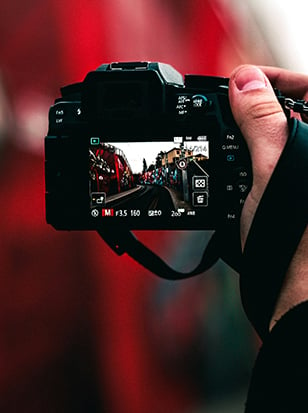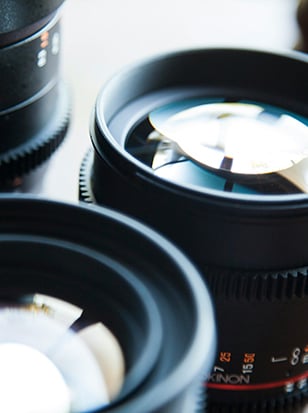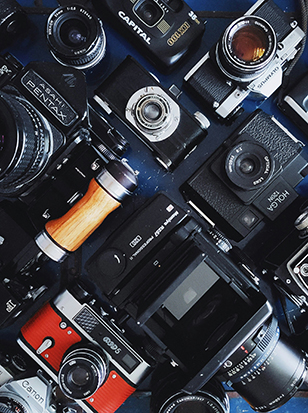
Welcome to our guide to understanding the different types of camera lenses. Cameras often make the headlines but lenses are perhaps the most important piece of equipment you can buy.
There are many types of lenses, all designed for different applications, creative disciplines and different skill levels. While creativity is key to photography and filmmaking, there is a general consensus for the main uses of specific focal lengths. Here’s a little breakdown that is in no way lens-gospel.
4mm - 14mm - These are generally known as fisheye lenses and are used for abstract and creative applications. Perhaps most notably, fisheye lenses are used when photographing skateboarding and surfing
14mm - 35mm - This focal range usually coincides with wide-angle lenses. This lens type is used all over the industry but is commonly used for landscape photography and architecture.
35mm - 85mm - Generally considered as standard focal lengths, this range is commonly used for street, portrait and travel photography. 35mm is a classic and versatile focal length and the images taken are a little wider than what we see naturally. The “nifty-fifty” is an industry-standard. And 85mm lenses make for stunning portraiture.
85mm - 135mm - Here we step up into the short telephoto range. These focal lengths give you that bit more reach and lend themselves to street photography and portraiture.
135mm+ - Medium telephoto lenses are where the action begins. Lenses with a 135mm focal length and beyond are primarily designed for wildlife and sports photography. The extra length allows you to be further away from the action while still capturing it.
300mm+ - Starting at 300mm and reaching lengths as high as 1200mm, these lenses fall into the super-telephoto category. Camera lenses with focal lengths are designed to capture subjects from a distance such as sports, nature and astronomy.
Of course, this breakdown doesn’t consider zoom lenses that often have a wide range of focal lengths within a single lens. It also doesn’t cover macro lenses that often have focal lengths from 35-200mm, but their intricate lens design captures images differently.
Additionally, it’s important to consider your camera’s sensor. Not all lenses are designed for every camera. Make sure to check whether your camera is a DSLR or a Mirrorless camera; does it have a full-frame or a crop sensor? Depending on the camera brand, most full-frame lenses can be used on crop-sensor cameras but crop-sensor lenses won’t work on full-frame cameras!
Let’s get into what lens types there are and what they’re designed for…
What is a Prime Lens?
A prime lens is a type of camera lens with a fixed focal length such as 35mm or 50mm. This means it has one specific field of view and cannot zoom in or out. Some consider them as less versatile than zoom lenses but for what they lack in an ability to zoom, they often provide a higher quality image and wider maximum aperture, providing excellent low-light performance and greater depth of field control.
Prime lenses are not confined to a single genre of photography or filmmaking; they are used across the creative spectrum. Additionally, they provide the opportunity to learn about focal lengths as they encourage you to move to find the best shot and be creative with your composition.
What is a Zoom Lens?
Zoom lenses offer a variable focal length, allowing you to adjust the composition and magnification of a scene without physically moving closer or farther from your subject. Take a 24-70mm lens; this lens can be set to 24mm, 70mm and all focal lengths in between, including 35mm and 50mm.
Zoom lenses are popular because of their versatility and are often used for events, sports photography and everyday use. However, while they offer flexibility, zoom lenses may sacrifice some optical quality compared to prime lenses.
What is a Wide-Angle Lens?
Wide-angle lenses, as the name suggests, offer a wide field of view. This lens type is generally used for landscape photography, architecture and interior design as the field of view is ideal for tight indoor spaces where you need to fit the entire scene into a single frame.
But that’s not all. Wide-angle lenses accentuate perspective meaning foreground subjects appear larger than they would using different lenses. This allows photographers and filmmakers to get creative with dramatic compositions and dynamic storytelling.
What is a Telephoto Lens?
Telephoto lenses have a longer focal length than wide-angle and standard lenses which enables them to magnify distant subjects. These lenses have a compression effect that changes the perspective of your scene; bringing distant subjects closer together and affecting the sense of depth.
Both prime and zoom telephoto lenses offer a focal reach that is essential for wildlife photography, sports, nature, photojournalism, or any scenario where you cannot physically get close to your subject. Telephoto zoom lenses benefit from a variable focal range meaning fewer lens changes and therefore, missed opportunities. But as with all zoom lenses, image quality may be somewhat sacrificed as a compromise for versatility.
What is a Macro Lens?
Macro lenses are specifically designed for extreme close-up photography and filmmaking. Using these lenses, you can capture intricate details that are not usually visible to the naked eye such as textures, insects and jewellery.
Many macro lenses will have what is referred to as a 1:1 ratio. This means that the photo of your subject is projected life-size onto the camera’s sensor. This lets you zoom in and see incredible detail, especially on high-resolution cameras. Other lenses go closer and show more detail with 2:1 or even 5:1 ratios, the latter showing a 5x life-size image. Any further than this and you border on microscopic imaging –– a whole different type of lens.
What is a Superzoom Lens?
A superzoom lens offers an extensive zoom range, covering an extreme focal range in a single lens. These lenses are versatile, flexible and remove the need to carry multiple lenses for different shooting scenarios. They’re great for travel photographers and those who prioritise convenience and ease.
However, such a focal range comes at the cost of optical quality. These lenses may never meet the same level of detail as a prime or a dedicated zoom lens. But depending on your needs, this type should be more than suitable.
What is a Pancake Lens?
Pancake lenses are super-compact and lightweight lenses that have a slim profile, somewhat resembling a pancake. They’re designed for portability and discretion and are ideal for street and travel photography, holidays and any scenario where you need a lightweight and inconspicuous setup.
Generally, their compact size results in a lower quality image when compared to standard lenses, simply due to having fewer optical elements. But they are small, simple to use and used by all levels of users.
What is a Tilt-Shift Lens?
A tilt-shift lens is a specialist lens that allows you to control the plane of focus and correct perspective distortion through the tilting and shifting of its optical elements.
While this type of lens offers the chance to experiment with perspective and selective focus, they’re generally used for commercial purposes such as architecture photography to correct lines and eliminate converging verticals (the effects of two parallel lines seeming to get closer e.g. when looking from the ground up at skyscrapers).
What is a Fisheye Lens?
Fisheye lenses are an ultra-wide-angle lens that produces a strong visual distortion, resulting in a wide hemispherical image. They generally have a focal range of 4-14mm that often exceeds 180 degrees, resulting in a distinct characteristic curricular appearance.
These lenses are best known for their creative visual effects which makes them popular for experimental and artistic photography. They were popularised in the 80s and 90s when used for skateboarding videos and photos as they provided a unique and dynamic perspective to the sport, creating a sense of immersion and distortion.
What is a Mirror Lens?
Mirror lenses are essentially compact telescopes. Unlike conventional camera lenses that use an array of glass elements to gather and transmit light, mirror lenses use a series of angled circular mirrors to reflect light back and forth until a highly magnified portion of the original image reaches the camera sensor.
The benefit of this setup is the same reach as a conventional telephoto lens but half the physical size. They are therefore prized for their portability and comparatively lower cost than other lenses. Mirror lenses are also characterised by the distinctive doughnut-shaped bokeh and the unique look they produce; often being used for wildlife and astrophotography.
However, this all comes at the cost of image quality and a single, usually slow f8 or f11, fixed aperture. If you have the time and creativity to make use of the benefits then they are totally worth it. But if you are looking for versatility and the highest image quality, this lens type may not be for you.

FAQs
What is an aperture?
An aperture is an adjustable hole within a lens that dictates how much light comes through the lens onto the camera sensor. When describing camera lenses the maximum aperture is the widest the hole can be and the minimum is the narrowest it can be.
The numbers after the focal length in a lens title refer to the maximum aperture at each end of the lens. So, an 18-55mm f3.5-5.6 lens offers a maximum aperture of f3.5 at the 18mm end and f5.6 at the 55mm end. Zoom lenses whose names only refer to one aperture – such as 24-70mm f2.8 – have this maximum aperture throughout the entire focal range. These are desirable but usually more expensive than those with a variable maximum aperture.
What is bokeh?
The bokeh effect refers to the aesthetic quality of the out-of-focus blur of an image. Achieved using a wide aperture, such as f2.8 or wider, the use of this effect is particularly effective at drawing your viewer’s eye to the focal of the photo or video. Intentional use of blur is commonly used in portrait and wildlife photography as well as cinematic videography.
What is lens distortion?
Lens distortion refers to optical imperfections when using a camera lens. There are two main types of lens distortion: barrel distortion and pincushion distortion. Barrel distortion often occurs in wide-angle lenses where straight lines appear to bow outward. Pincushion distortion is the opposite. It is commonly seen in telephoto lenses and causes straight lines to bow inward.
What is chromatic aberration?
Chromatic aberration (CA) is a phenomenon that occurs when a lens fails to focus all colours to the same point, leading to colour fringing or halos around the edges of objects. Chromatic aberration can be classified into two main types: lateral (or transverse) chromatic aberration and longitudinal (or axial) chromatic aberration.
What is a manual lens?
Manual lenses require the photographer or filmmaker to adjust their focus, aperture and occasionally exposure settings manually, without autofocus or electronic controls. They are often considered to be more demanding on skill and precision but also offer a hands-on and tactile experience and appeal to the artistry of the image-taking process.
What is an AF lens?
An AF lens (autofocus) is equipped with an electronic control and motor system that communicates with the camera’s sensor to automatically find focus on a user-defined subject or area. Modern cameras have advanced AF algorithms that work with AF lenses to automatically identify a range of subjects without user direction.
What is a Portrait Lens?
Portrait lenses are simply lenses that are well-suited to the art of portraiture. They feature attributes that help users capture stunning images such as a focal range of 50mm to 85mm (on a full-frame camera) that provides a natural perspective that complements facial features. They often have a wide maximum aperture that allows for greater control of depth of field, allowing you to create a beautifully blurred and bokeh-rich background, while your subject is pin-sharp and detailed.
About the Author
Leo White has been part of the Wex Photo Video team since 2018, taking on roles from the contact centre to the product setup team. Holding both a BA and an MA in photography, Leo brings a wealth of expertise he’s always ready to share.
Sign up for our newsletter today!
- Subscribe for exclusive discounts and special offers
- Receive our monthly content roundups
- Get the latest news and know-how from our experts




